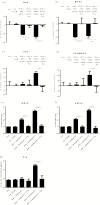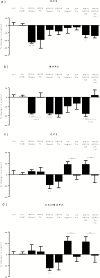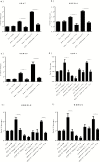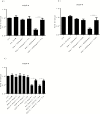Interferon-Alpha Reduces Human Hippocampal Neurogenesis and Increases Apoptosis via Activation of Distinct STAT1-Dependent Mechanisms
- PMID: 29040650
- PMCID: PMC5793815
- DOI: 10.1093/ijnp/pyx083
Interferon-Alpha Reduces Human Hippocampal Neurogenesis and Increases Apoptosis via Activation of Distinct STAT1-Dependent Mechanisms
Abstract
Background: In humans, interferon-α treatment for chronic viral hepatitis is a well-recognized clinical model for inflammation-induced depression, but the molecular mechanisms underlying these effects are not clear. Following peripheral administration in rodents, interferon-α induces signal transducer and activator of transcription-1 (STAT1) within the hippocampus and disrupts hippocampal neurogenesis.
Methods: We used the human hippocampal progenitor cell line HPC0A07/03C to evaluate the effects of 2 concentrations of interferon-α, similar to those observed in human serum during its therapeutic use (500 pg/mL and 5000 pg/mL), on neurogenesis and apoptosis.
Results: Both concentrations of interferon-α decreased hippocampal neurogenesis, with the high concentration also increasing apoptosis. Moreover, interferon-α increased the expression of interferon-stimulated gene 15 (ISG15), ubiquitin-specific peptidase 18 (USP18), and interleukin-6 (IL-6) via activation of STAT1. Like interferon-α, co-treatment with a combination of ISG15, USP18, and IL-6 was able to reduce neurogenesis and enhance apoptosis via further downstream activation of STAT1. Further experiments showed that ISG15 and USP18 mediated the interferon-α-induced reduction in neurogenesis (potentially through upregulation of the ISGylation-related proteins UBA7, UBE2L6, and HERC5), while IL-6 mediated the interferon-α-induced increase in apoptosis (potentially through downregulation of aquaporin 4). Using transcriptomic analyses, we showed that interferon-α regulated pathways involved in oxidative stress and immune response (e.g., Nuclear Factor (erythroid-derived 2)-like 2 [Nrf2] and interferon regulatory factor [IRF] signaling pathway), neuronal formation (e.g., CAMP response element-binding protein [CREB] signaling), and cell death regulation (e.g., tumor protein(p)53 signaling).
Conclusions: We identify novel molecular mechanisms mediating the effects of interferon-α on the human hippocampus potentially involved in inflammation-induced neuropsychiatric symptoms.
Keywords: apoptosis; depression; inflammation; interferon-alpha; neurogenesis.
© The Author 2017. Published by Oxford University Press on behalf of CINP.
Figures







Similar articles
-
Downregulation of SOCS1 increases interferon-induced ISGylation during differentiation of induced-pluripotent stem cells to hepatocytes.JHEP Rep. 2022 Sep 23;4(12):100592. doi: 10.1016/j.jhepr.2022.100592. eCollection 2022 Dec. JHEP Rep. 2022. PMID: 36439639 Free PMC article.
-
The role of omega-3 fatty acids in preventing glucocorticoid-induced reduction in human hippocampal neurogenesis and increase in apoptosis.Transl Psychiatry. 2020 Jul 7;10(1):219. doi: 10.1038/s41398-020-00908-0. Transl Psychiatry. 2020. PMID: 32636362 Free PMC article.
-
Lipopolysaccharide and Tumor Necrosis Factor Alpha Inhibit Interferon Signaling in Hepatocytes by Increasing Ubiquitin-Like Protease 18 (USP18) Expression.J Virol. 2016 May 27;90(12):5549-5560. doi: 10.1128/JVI.02557-15. Print 2016 Jun 15. J Virol. 2016. PMID: 27009955 Free PMC article.
-
Genetic and Epigenetic Regulation of the Innate Immune Response to Gout.Immunol Invest. 2023 Apr;52(3):364-397. doi: 10.1080/08820139.2023.2168554. Epub 2023 Feb 6. Immunol Invest. 2023. PMID: 36745138 Review.
-
Recent advances in the anti-HCV mechanisms of interferon.Acta Pharm Sin B. 2014 Aug;4(4):241-7. doi: 10.1016/j.apsb.2014.06.010. Epub 2014 Jul 14. Acta Pharm Sin B. 2014. PMID: 26579391 Free PMC article. Review.
Cited by
-
Aquaporin 4 and brain-related disorders: Insights into its apoptosis roles.EXCLI J. 2021 Jun 1;20:983-994. doi: 10.17179/excli2021-3735. eCollection 2021. EXCLI J. 2021. PMID: 34267610 Free PMC article. Review.
-
Postnatal immune activation causes social deficits in a mouse model of tuberous sclerosis: Role of microglia and clinical implications.Sci Adv. 2021 Sep 17;7(38):eabf2073. doi: 10.1126/sciadv.abf2073. Epub 2021 Sep 17. Sci Adv. 2021. PMID: 34533985 Free PMC article.
-
Modulation of microglial activation by antidepressants.J Psychopharmacol. 2022 Feb;36(2):131-150. doi: 10.1177/02698811211069110. Epub 2022 Jan 29. J Psychopharmacol. 2022. PMID: 35098788 Free PMC article. Review.
-
Neurogenesis is disrupted in human hippocampal progenitor cells upon exposure to serum samples from hospitalized COVID-19 patients with neurological symptoms.Mol Psychiatry. 2022 Dec;27(12):5049-5061. doi: 10.1038/s41380-022-01741-1. Epub 2022 Oct 5. Mol Psychiatry. 2022. PMID: 36195636 Free PMC article.
-
Breaking down the cellular responses to type I interferon neurotoxicity in the brain.Front Immunol. 2023 Feb 3;14:1110593. doi: 10.3389/fimmu.2023.1110593. eCollection 2023. Front Immunol. 2023. PMID: 36817430 Free PMC article. Review.
References
-
- Alboni S, Gibellini L, Montanari C, Benatti C, Benatti S, Tascedda F, Brunello N, Cossarizza A, Pariante CM(2013)N-acetyl-cysteine prevents toxic oxidative effects induced by IFN-alpha in human neurons. Int J Neuropsychopharmacol 16:1849–1865. - PubMed
-
- Anacker C, Cattaneo A, Luoni A, Musaelyan K, Zunszain PA, Milanesi E, Rybka J, Berry A, Cirulli F, Thuret S, Price J, Riva MA, Gennarelli M, Pariante CM (2013a) Glucocorticoid-related molecular signaling pathways regulating hippocampal neurogenesis. Neuropsychopharmacology 38:872–883. - PMC - PubMed
-
- Anacker C, Cattaneo A, Musaelyan K, Zunszain PA, Horowitz M, Molteni R, Luoni A, Calabrese F, Tansey K, Gennarelli M, Thuret S, Price J, Uher R, Riva MA, Pariante CM (2013b) Role for the kinase SGK1 in stress, depression, and glucocorticoid effects on hippocampal neurogenesis. Proc Natl Acad Sci U S A 110:8708–8713. - PMC - PubMed
Publication types
MeSH terms
Substances
Grants and funding
LinkOut - more resources
Full Text Sources
Other Literature Sources
Medical
Research Materials
Miscellaneous

